Snow Avalanche Assessment in Mass Movement-Prone Areas: Results from Climate Extremization in Relationship with Environmental Risk Reduction in the Prati di Tivo Area (Gran Sasso Massif, Central Italy)
Abstract
1. Introduction
2. Study Area
2.1. Geological and Geomorphological Setting
2.2. Climatic Setting
3. Materials and Methods
3.1. Morphometric Analysis
3.2. Geomorphological Analysis
3.3. Climatic Analysis
3.4. Nivological Analysis
3.5. Snow Avalanche Hazard Assessment
- the avalanche return period—the average number of years between two events of the same intensity;
- the avalanche pressure—the forces per unit of surface exercised by the avalanche on a flat obstacle of big dimensions disposed perpendicularly to the trajectory of the advancing mass of snow. The pressure can be determined with reference to both the dynamic and static components of the solicitation.
4. Results
4.1. Morphometric Analysis
4.2. Geomorphological Analysis
4.3. Climatic Analysis
4.4. Nivological Analysis
- The Prati di Tivo area shows a regular snow cover every year relatively abundant in certain winter seasons, such as 1994/1995, 1998/1999, and 2004/2005, with cumulative values greater than 400 cm. Only during the 1988/1989 winter season, the cumulative was less than 100 cm (Figure 9a). Recently, a more significant snowfall irregularity occurred, with long phases characterized by the absence of snow phenomena, alternating with short but intense heavy snowfalls events. Accumulations seem to have increased against a lower persistence of the snow cover. The trend analysis referring to the aforementioned period depicts a clear rise in the signal—over 3 cm per winter season—deriving from the highly irregular nivometric trend, with a hint of a ten years of periodicity and a more recent signal of about 3.8 cm per winter season detected on average for the Central Appennines Chain [100,119,122].
- Heavy snowfalls already occur from the middle of November. They are common throughout the winter and until the second half of March, becoming sporadic in April (Figure 9b). By accounting for the available datasets, the absolute monthly maximum values occurred in January 2017 at about 425 cm distributed in only seven days [119]. The winter’s least snowy month is estimated to be December. The snowfall regime (Figure 8b) presents a unimodal distribution, with the maximum values detected in January and February. Arguably, for altitudes greater than 2000 m a.s.l., the trend tends to become fairly regular if not bimodal with a second peak during the spring, given the notable snowfall increase in March and April, as detected at the Campo Imperatore gauge (2137 m a.s.l.).
- The number of snowy days shows considerable intra-seasonal variations, strictly dependent on the synoptic seasonal evolution. This aspect was particularly evident in the last decade, albeit in a context of significant snowiness, with values ranging between 25 and 35 events per season, with peaks of about 40. During the last seasons, a general decrease of the phenomenology seemed to be occurring; these are increasingly concentrated in a few days and present a greater intensity, which underlines the climatic extremization in progress. Furthermore, a delay at the beginning of the snowy season seems evident, along with a greater frequency of events at the beginning of the spring season.
- Daily snowfall data (Figure 10a) highlight the possible occurrence of snowy events of high intensity and short-to-moderate durations. In particular, the maximum recorded daily amount of fresh snow is around 70 cm (13 February 1986 and 23 March 2009). Moreover, it is essential to consider unofficial recordings performed on 17–19 January 2017 (when abundant avalanche events occurred, reaching the Prati di Tivo area and causing considerable damages to infrastructures and ski facilities), which pointed out a daily maximum of 140 cm on 17 January and of 310 cm for the whole three-day period.
- Significant sudden temperature changes occurring more frequently after or during snowfalls generally disfavor the cohesion process between the strata composing the snow cover, thus causing a hypothetical increase of the avalanche hazard. Nevertheless, a clear Mediterranean type, the climatic extremization, and a not-excessively-high elevation determine an early beginning of the accelerated destructive metamorphism processes, with a subsequent quick decrease of the snow depth values on the ground up to the maximum elevation of avalanche-prone areas. Furthermore, close to detachments areas, a strong wind power occurring during and after snowfalls induces rapid mechanical metamorphism. In the case of intense snow events followed by exceptionally cold climatic phases and variable weather conditions, destructive metamorphism processes take place very slowly; constructive metamorphism is indeed established. The thickness of the snow cover remains relatively abundant for a long time (Figure 10b).
- Days with mixed snowfall and rainfall events or entirely rainy ones are also estimated to occur during the winter season. This is connected to the synoptic conditions inducing rainfall and to the eventual mixing within the frontal system. Field evidence and surveys in specific sites suggest that this has a significant repercussion on natural avalanche occurrences, especially below 1900 m a.s.l.
- From field surveys, as well as from the avalanche inventory and literature data (i.e., Meteomont service), it results that, in correspondence with a sudden temperature rise, avalanche events may occur with loose surface cohesion values already in the 24–36 h following the snowfall events, involving many buildings and anthropic structures present in the Prati di Tivo area.
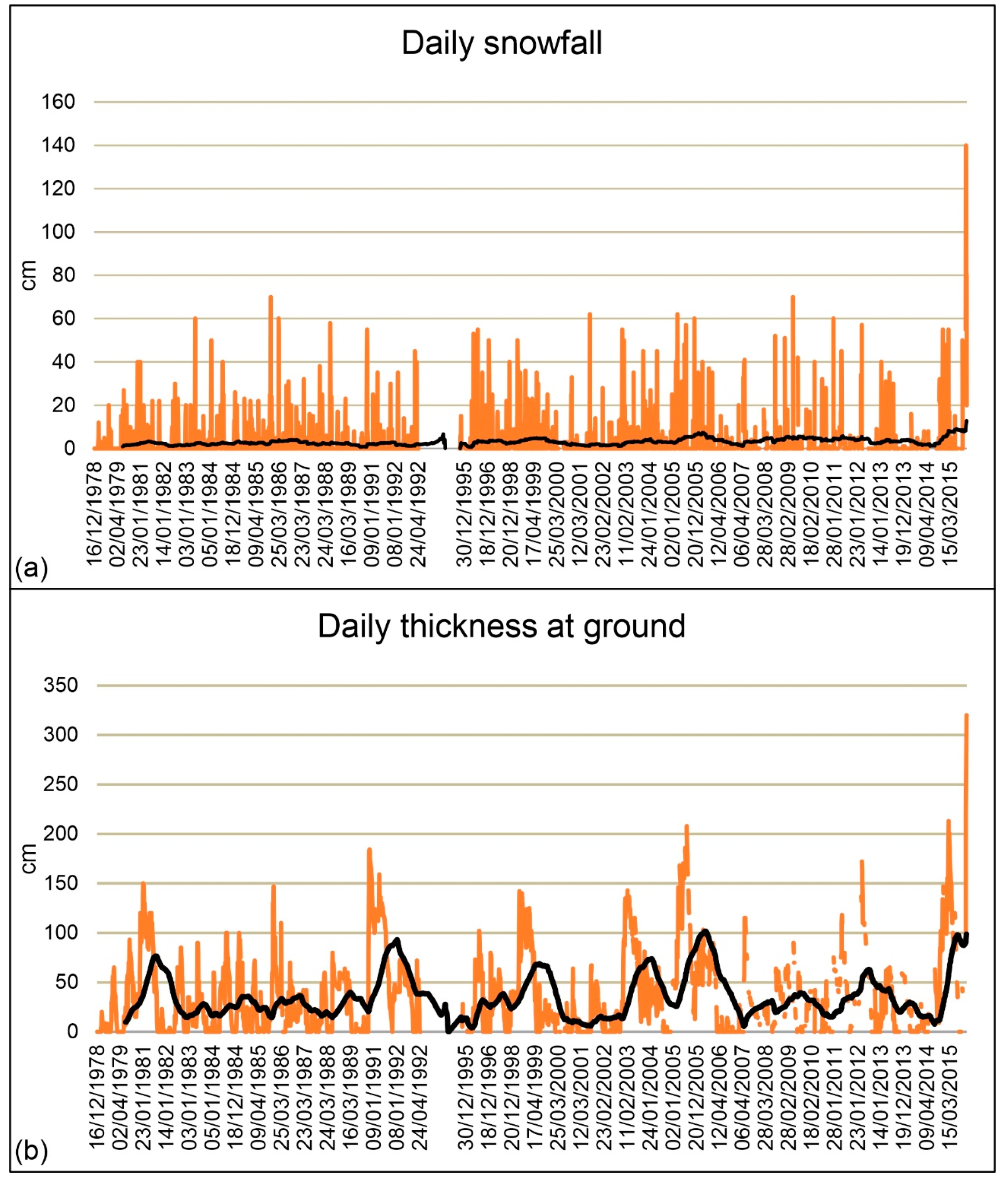
4.5. Snow Avalanche Hazard Assessment
- April 1929 (not reported in the official database of Abruzzo Region)—A large avalanche event reached the Guide Shelter (Rifugio delle Guide in Italian).
- 7 April 1978—A large avalanche, detached from the northern escarpment of the Corno Piccolo ridge, moved down through rock gullies and affected the ski lift and the other facilities downstream to the Madonnina location.
- 8 January 1981—An avalanche, detached from the northern slopes of the Corno Piccolo ridge, affected some houses and buildings located at Prati di Tivo.
- 2 March 1984—An avalanche affected the study area and posed in a threat the Madonnina chairlift bar.
- 3 March 1999—A large avalanche hit the study area, causing several damages to the ski facilities (e.g., pylons, intermediate station, and ticket office).
5. Discussions
- Slightly downstream of the prominent peak (Corno Piccolo, 2655 m a.s.l.) at an elevation of about 2550 m a.s.l., a detachment area was visible, as graphically shown in Figure 16a. Moreover, according to no official local chronicles and eyewitness reports, it seemed to correspond with the site of an avalanche never reported and stored in the Geodatabase of the Abruzzo Region.
- Significant snow accumulations generated by the snow mass releases produced by the Obellx® devices on the 25th and 26th of March were visible throughout the escarpment.
6. Conclusions
Author Contributions
Funding
Institutional Review Board Statement
Informed Consent Statement
Data Availability Statement
Acknowledgments
Conflicts of Interest
References
- Beniston, M.; Farinotti, D.; Stoffel, M.; Andreassen, L.M.; Coppola, E.; Eckert, N.; Fantini, A.; Giacona, F.; Hauck, C.; Huss, M.; et al. The European mountain cryosphere: A review of its current state, trends, and future challenges. Cryosphere 2018, 12, 759–794. [Google Scholar] [CrossRef]
- Guerra, A.J.T.; Fullen, M.A.; Jorge, M.D.C.O.; Bezzerra, J.F.R.; Shork, M.S. Slope Processes, Mass Movement and Soil Erosion: A Review. Pedosphere 2017, 27, 27–41. [Google Scholar] [CrossRef]
- Solari, L.; Del Soldato, M.; Raspini, F.; Barra, A.; Bianchini, S.; Confuorto, P.; Casagli, N.; Crosetto, M. Review of satellite interferometry for landslide detection in Italy. Remote Sens. 2020, 12, 1351. [Google Scholar] [CrossRef]
- Leroueil, S.; Locat, J. Slope movements—Geotechnical characterization, risk assessment and mitigation. In Geotechnical Hazards; Maric, B., Lisac, L., Szavits-Nossan, A., Eds.; Balkema: Rotterdam, The Netherlands, 1998; pp. 95–106. [Google Scholar]
- Martino, S.; Antonielli, B.; Bozzano, F.; Caprari, P.; Discenza, M.E.; Esposito, C.; Fiorucci, M.; Iannucci, R.; Marmoni, G.M.; Schilirò, L. Landslides triggered after the 16 August 2018 Mw 5.1 Molise earthquake (Italy) by a combination of intense rainfalls and seismic shaking. Landslides 2020, 17, 1177–1190. [Google Scholar] [CrossRef]
- Aleotti, P.; Chowdhury, R. Landslide hazard assessment: Summary review and new perspectives. Bull. Eng. Geol. Environ. 1999, 58, 21–44. [Google Scholar] [CrossRef]
- Glade, T.; Anderson, M.; Crozier, M.J. Landslide Hazard and Risk; John Wiley & Sons Ltd.: Chichester, UK, 2012; ISBN 9780470012659. [Google Scholar]
- Marsala, V.; Galli, A.; Paglia, G.; Miccadei, E. Landslide susceptibility assessment of Mauritius Island (Indian ocean). Geosci. 2019, 9, 493. [Google Scholar] [CrossRef]
- Peruccacci, S.; Brunetti, M.T.; Gariano, S.L.; Melillo, M.; Rossi, M.; Guzzetti, F. Rainfall thresholds for possible landslide occurrence in Italy. Geomorphology 2017, 290, 39–57. [Google Scholar] [CrossRef]
- Quesada-Román, A.; Fallas-López, B.; Hernández-Espinoza, K.; Stoffel, M.; Ballesteros-Cánovas, J.A. Relationships between earthquakes, hurricanes, and landslides in Costa Rica. Landslides 2019, 16, 1539–1550. [Google Scholar] [CrossRef]
- Tanyaş, H.; van Westen, C.J.; Allstadt, K.E.; Jessee, M.A.N.; Görüm, T.; Jibson, R.W.; Godt, J.W.; Sato, H.P.; Schmitt, R.G.; Marc, O.; et al. Presentation and Analysis of a Worldwide Database of Earthquake-Induced Landslide Inventories. J. Geophys. Res. Earth Surf. 2017, 122, 1991–2015. [Google Scholar] [CrossRef]
- Calista, M.; Miccadei, E.; Piacentini, T.; Sciarra, N. Morphostructural, Meteorological and Seismic Factors Controlling Landslides in Weak Rocks: The Case Studies of Castelnuovo and Ponzano (North East Abruzzo, Central Italy). Geosciences 2019, 9, 122. [Google Scholar] [CrossRef]
- Nadim, F.; Kjekstad, O.; Peduzzi, P.; Herold, C.; Jaedicke, C. Global landslide and avalanche hotspots. Landslides 2006, 3, 159–173. [Google Scholar] [CrossRef]
- Rahmati, O.; Ghorbanzadeh, O.; Teimurian, T.; Mohammadi, F.; Tiefenbacher, J.P.; Falah, F.; Pirasteh, S.; Ngo, P.T.T.; Bui, D.T. Spatial modeling of snow avalanche using machine learning models and geo-environmental factors: Comparison of effectiveness in two mountain regions. Remote Sens. 2019, 11, 2995. [Google Scholar] [CrossRef]
- CRED EM-DAT. The International Disaster Database. Available online: https://www.emdat.be (accessed on 14 February 2021).
- Statham, G.; Haegeli, P.; Greene, E.; Birkeland, K.; Israelson, C.; Tremper, B.; Stethem, C.; McMahon, B.; White, B.; Kelly, J. A conceptual model of avalanche hazard. Nat. Hazards 2018, 90, 663–691. [Google Scholar] [CrossRef]
- Voiculescu, M.; Ardelean, F.; Török-Oance, M.; Milian, N. Topographical factors, meteorological variables and human factors in the control of the main snow avalanche events in the fĂgĂraŞ massif (Southern carpathians—Romanian Carpathians): Case studies. Geogr. Pol. 2016, 8, 47–64. [Google Scholar] [CrossRef]
- Navarre, J.P. The principles of snow mechanics: The mechanical properties of snow. In Proceedings of the Université Européenne d’été sur les Risques Naturels: Neige et Avalanches; Brugnot, G., Ed.; Cemagref Publications: Chamonix, France, 1992; pp. 75–86. [Google Scholar]
- Fort, M.; Cossart, E.; Deline, P.; Dzikowski, M.; Nicoud, G.; Ravanel, L.; Schoeneich, P.; Wassmer, P. Geomorphic impacts of large and rapid mass movements: A review. Geomorphol. Reli. Process. Environ. 2009, 15, 47–64. [Google Scholar] [CrossRef]
- Ghinoi, A.; Chung, C.J. STARTER: A statistical GIS-based model for the prediction of snow avalanche susceptibility using terrain features—Application to Alta Val Badia, Italian Dolomites. Geomorphology 2005, 66, 305–325. [Google Scholar] [CrossRef]
- Borrel, G. La Carte de Localisation Probable des Avalanches. Mappemonde 1994, 94, 17–19. [Google Scholar]
- Gruber, U.; Bartelt, P.; Haefher, H. Avalanche hazard mapping using numerical Voellmy-fluid models. Publ. Norges Geotek. Inst. 1998, 203, 117–121. [Google Scholar]
- Sauermoser, S. Aavalanche hazard mapping—30 years’ experience in Austria. In Proceedings of the 2006 International 901 Snow Science Workshop, Telluride, CO, USA, 1–6 October 2006; pp. 314–321. [Google Scholar]
- Bründl, M.; Margreth, S. Integrative Risk Management: The Example of Snow Avalanches. In Snow and Ice-Related Hazards, Risks, and Disasters; Haeberli, W., Whiteman, C., Shroder, J.F., Eds.; Elsevier Inc.: Oxford, UK, 2015; pp. 263–301. ISBN 9780123964731. [Google Scholar]
- Sinickas, A.; Jamieson, B.; Maes, M.A. Snow avalanches in western Canada: Investigating change in occurrence rates and implications for risk assessment and mitigation. Struct. Infrastruct. Eng. 2016, 12, 490–498. [Google Scholar] [CrossRef]
- Mellor, M. Controlled release of avalanches by explosives. In Advances in North American Avalanche Technology: 1972 Symposium; Perla, R., Ed.; USDA Forest Service: Washington DC, USA, 1973; pp. 37–49. [Google Scholar]
- Gubler, H. Artificial Release of Avalanches by Explosives. J. Glaciol. 1977, 19, 419–429. [Google Scholar] [CrossRef]
- Binger, C.; Nelsen, J.; Olson, K.A. Explosive shock wave compression in snow: Effects of explosive orientation and snowpack compression. In Proceedings of the ISSW 2006. International Snow Science Workshop, Telluride, CO, USA, 1–6 October 2006; Gleason, J.A., Ed.; Montana State University Library: Bozeman, MT, USA, 2006; pp. 592–597. [Google Scholar]
- Frigo, B.; Chiaia, B.; Cardu, M. Snowpack effects induced by blasts: Experimental measurements vs theoretical formulas. In Proceedings of the ISSW 2012. International Snow Science Workshop, Anchorage, AK, USA, 16–21 September 2012; Montana State University Library: Bozeman, MT, USA, 2012; pp. 943–947. [Google Scholar]
- Johnson, J.B.; Solie, D.J.; Barrett, S.A. The response of a seasonal snow cover to explosive loading. Ann. Glaciol. 1994, 19, 49–54. [Google Scholar] [CrossRef]
- Barbolini, M.; Cordola, M.; Natale, L.; Tecilla, G. Hazard mapping and land use regulation in avalanche prone areas: Recent developments in Italy. In Recommendations to Deal with Snow Avalanches in Europe; Hervas, J., Ed.; ISPRA: Rome, Italy, 2003. [Google Scholar]
- Gubler, H.; Wyssen, S.; Kogelnig, A. Guidelines for Artificial Release of Avalanches; Wyssen Avalanche Control AG: Reichenbach, Germany, 2012; p. 48. [Google Scholar]
- Canadian Avalanche Association (CAA). Technical Aspects of Snow Avalanche Risk Management—Resources and Guidelines for Avalanche Practitioners in Canada; Campbell, C., Conger, S., Gould, B., Haegeli, P., Jamieson, B., Statham, G., Eds.; Canadian Avalanche Association: Revelstoke, BC, Canada, 2016; p. 126. [Google Scholar]
- Choubin, B.; Borji, M.; Hosseini, F.S.; Mosavi, A.; Dineva, A.A. Mass wasting susceptibility assessment of snow avalanches using machine learning models. Sci. Rep. 2020, 10, 18363. [Google Scholar] [CrossRef] [PubMed]
- Jamieson, B.; Margreth, S.; Jones, A. Application and Limitations of Dynamic Models for Snow Avalanche Hazard Mapping. In Proceedings of the International snow science workshop proceedings 2008, Whistler, BC, Canada, 22 September 2008; pp. 730–739. [Google Scholar]
- McClung, D.M.; Lied, K. Statistical and geometrical definition of snow avalanche runout. Cold Reg. Sci. Technol. 1987, 13, 107–119. [Google Scholar] [CrossRef]
- Voiculescu, M. Patterns of the dynamics of human-triggered snow avalanches at the Fǎgǎras massif (Southern Carpathians), Romanian Carpathians. Area 2014, 46, 328–336. [Google Scholar] [CrossRef]
- Sharma, S.; Ganju, A. Complexities of avalanche forecasting in western Himalayas—An overview. Cold Reg. Sci. Technol. 2000, 31, 95–102. [Google Scholar] [CrossRef]
- Gruber, U.; Bartelt, P. Snow avalanche hazard modelling of large areas using shallow water numerical methods and GIS. Environ. Model. Softw. 2007, 22, 1472–1481. [Google Scholar] [CrossRef]
- Valero, C.V.; Wever, N.; Bühler, Y.; Stoffel, L.; Margreth, S.; Bartelt, P. Modelling wet snow avalanche runout to assess road safety at a high-Altitude mine in the central Andes. Nat. Hazards Earth Syst. Sci. 2016, 16, 2303–2323. [Google Scholar] [CrossRef]
- Choubin, B.; Borji, M.; Mosavi, A.; Sajedi-Hosseini, F.; Singh, V.P.; Shamshirband, S. Snow avalanche hazard prediction using machine learning methods. J. Hydrol. 2019, 577, 123929. [Google Scholar] [CrossRef]
- Gaume, J.; van Herwijnen, A.; Gast, T.; Teran, J.; Jiang, C. Investigating the release and flow of snow avalanches at the slope-scale using a unified model based on the material point method. Cold Reg. Sci. Technol. 2019, 168, 102847. [Google Scholar] [CrossRef]
- Bühler, Y.; Kumar, S.; Veitinger, J.; Christen, M.; Stoffel, A. Snehmani Automated identification of potential snow avalanche release areas based on digital elevation models. Nat. Hazards Earth Syst. Sci. 2013, 13, 1321–1335. [Google Scholar] [CrossRef]
- Pecci, M.; D’Aquila, P. Zonazione delle aree valanghive a partire dalla suscettibilità al distacco di valanghe. Neve e Valanghe 2010, 69, 36–47. [Google Scholar]
- Yariyan, P.; Avand, M.; Abbaspour, R.A.; Karami, M.; Tiefenbacher, J.P. GIS-based spatial modeling of snow avalanches using four novel ensemble models. Sci. Total Environ. 2020, 745, 141008. [Google Scholar] [CrossRef]
- Romeo, V.; Fazzini, M. La neve in Appennino. Prime analisi su 30 anni di dati nivometeorologici. Neve e Valanghe 2008, 60, 58–67. [Google Scholar]
- D’Alessandro, L.; De Sisti, G.; D’Orefice, M.; Pecci, M.; Ventura, M. Geomorphology of the summit area of the Gran Sasso d’Italia. Geogr. Fis. Din. Quat. 2003, 26, 126–141. [Google Scholar]
- Miccadei, E.; Piacentini, T.; Buccolini, M. Long-term geomorphological evolution in the Abruzzo area, Central Italy: Twenty years of research. Geol. Carpathica 2017, 68, 19–28. [Google Scholar] [CrossRef]
- Piacentini, T.; Miccadei, E. The role of drainage systems and intermontane basins in the Quaternary landscape of the Central Apennines chain (Italy). Rend. Lincei 2014, 25, 139–150. [Google Scholar] [CrossRef]
- Cavinato, G.P.; Miccadei, E. Sintesi preliminare delle caratteristiche tettoniche e sedimentarie dei depositi quaternari della Conca di Sulmona (L’Aquila). Alp. Mediterr. Quat. 1995, 8, 129–140. [Google Scholar]
- Speranza, F.; Adamoli, L.; Maniscalco, R.; Florindo, F. Genesis and evolution of a curved mountain front: Paleomagnetic and geological evidence from the Gran Sasso range (Central Apennines, Italy). Tectonophysics 2003, 362, 183–197. [Google Scholar] [CrossRef]
- Calamita, F.; Satolli, S.; Scisciani, V.; Esestime, P.; Pace, P. Contrasting styles of fault reactivation in curved orogenic belts: Examples from the central Apennines (Italy). Bull. Geol. Soc. Am. 2011, 123, 1097–1111. [Google Scholar] [CrossRef]
- Vezzani, L.; Festa, A.; Ghisetti, F.C. Geology and tectonic evolution of the Central-Southern Apennines, Italy. Spec. Pap. Geol. Soc. Am. 2010, 469, 1–58. [Google Scholar] [CrossRef]
- Cardello, G.L.; Doglioni, C. From Mesozoic rifting to Apennine orogeny: The Gran Sasso range (Italy). Gondwana Res. 2015, 27, 1307–1334. [Google Scholar] [CrossRef]
- Pace, P.; Di Domenica, A.; Calamita, F. Summit low-angle faults in the Central Apennines of Italy: Younger-on-older thrusts or rotated normal faults? Constraints for defining the tectonic style of thrust belts. Tectonics 2014, 33, 756–785. [Google Scholar] [CrossRef]
- Adamoli, L.; Bertini, T.; Chiocchini, M.; Deiana, G.; Mancinelli, A.; Pieruccini, U.; Romano, A. Ricerche geologiche sul Mesozoico del Gran Sasso d’Italia (Abruzzo). II. Evoluzione tettonico-sedimentaria dal Trias superiore al Cretaceo inferiore dell’area compresa tra il Corno Grande e S. Stefano di Sessanio (F. 140 Teramo). Stud. Geol. Camerti 1978, 4, 7–17. [Google Scholar]
- Adamoli, L.; Bertini, T.; Deiana, G.; Pieruccini, U.; Romano, A. Ricerche geologiche sul Gran Sasso d’Italia (Abruzzo). VI. Primi risultati dello studio strutturale della catena del Gran Sasso d’Italia. Stud. Geol. Camerti 1982, 7, 97–103. [Google Scholar]
- Adamoli, L. Evidenze di tettonica di inversione nell’area Corno Grande—Corno Piccolo (Gran Sasso d’Italia). Boll. Della Soc. Geol. Ital. 1992, 111, 53–66. [Google Scholar]
- Carabella, C.; Buccolini, M.; Galli, L.; Miccadei, E.; Paglia, G.; Piacentini, T. Geomorphological analysis of drainage changes in the NE Apennines piedmont area: The case of the middle Tavo River bend (Abruzzo, Central Italy). J. Maps 2020, 16, 222–235. [Google Scholar] [CrossRef]
- Rovida, A.; Locati, M.; Camassi, R.; Lolli, B.; Gasperini, P.; Antonucci, A. The Italian Earthquake Catalogue CPTI15—Version 3.0; Istituto Nazionale di Geofisica e Vulcanologia (INGV): Rome, Italy, 2021. [Google Scholar] [CrossRef]
- Geurts, A.H.; Whittaker, A.C.; Gawthorpe, R.L.; Cowie, P.A. Transient landscape and stratigraphic responses to drainage integration in the actively extending central Italian Apennines. Geomorphology 2020, 353, 107013. [Google Scholar] [CrossRef]
- Ciccacci, S.; D’Alessandro, L.; Dramis, F.; Miccadei, E. Geomorphologic evolution and neotectonics of the Sulmona intramontane basin (Abruzzi Apennine, Central Italy). Z. Fur. Geomorphol. Suppl. 1999, 118, 27–40. [Google Scholar]
- Giraudi, C. I rock glacier tardo-pleistocenici e olocenici dell’Appennino—Età, distribuzione, significato paleoclimatico. Quat. Ital. J. Quat. Sci. 2002, 15, 45–52. [Google Scholar]
- Pecci, M.; D’Agata, C.; Smiraglia, C. Ghiacciaio del calderone (Apennines, Italy): The mass balance of a shrinking mediterranean glacier. Geogr. Fis. Din. Quat. 2008, 31, 55–62. [Google Scholar]
- Pecci, M.; D’Aquila, P. Geomorphological features and cartography of the Gran Sasso d’Italia massif between Corno Grande-Corno Piccolo and Pizzo Intermesoli. Geogr. Fis. Din. Quat. 2011, 34, 127–143. [Google Scholar]
- Bianchi-Fasani, G.; Esposito, C.; Lenti, L.; Martino, S.; Pecci, M.; Scarascia-Mugnozza, G. Seismic analysis of the Gran Sasso catastrophic rockfall (Central Italy). In Proceedings of the Landslide Science and Practice: Risk Assessment, Management and Mitigation; Mrgottini, C., Ed.; Springer: Berlin, Germany, 2013; pp. 263–267. [Google Scholar]
- Gruppo di lavoro. Gruppo di Lavoro CPTI Catalogo Parametrico dei Terremoti Italiani, 2004 (CPTI04); Editrice Compositori: Bologna, Italy, 2004. [Google Scholar]
- Chiarabba, C.; Jovane, L.; DiStefano, R. A new view of Italian seismicity using 20 years of instrumental recordings. Tectonophysics 2005, 395, 251–268. [Google Scholar] [CrossRef]
- ISIDe Working Group. Italian Seismological Instrumental and Parametric Database (ISIDe); Istituto Nazionale di Geofisica e Vulcanologia (INGV): Rome, Italy, 2007. [Google Scholar] [CrossRef]
- Peel, M.C.; Finlayson, B.L.; McMahon, T.A. Updated world map of the Köppen-Geiger climate classification. Spatial Data Access Tool (SDAT)OGC Standards-based Geospatial Data Visualization/Download. Hydrol. Earth Syst. 2007, 11, 1633–1644. [Google Scholar] [CrossRef]
- Di Lena, B.; Antenucci, F.; Mariani, L. Space and time evolution of the Abruzzo precipitation. Ital. J. Agrometeorol. 2012, 1, 5–20. [Google Scholar]
- Miccadei, E.; Piacentini, T.; Daverio, F.; Di, R. Geomorphological Instability Triggered by Heavy Rainfall: Examples in the Abruzzi Region (Central Italy). In Studies on Environmental and Applied Geomorphology; Piacentini, T., Miccadei, E., Eds.; IntechOpen: London, UK, 2012; pp. 45–62. [Google Scholar]
- Chiaudani, A.; Antenucci, F.; Di Lena, B. Historical analysis of maximum intensity precipitation(1, 3, 6, 12 hours) in Abruzzo Region (Italy)—Period 1951–2012. In Proceedings of the Agrometeorologia per la Sicurezza Ambientale ed Alimentare; 2013. Available online: http://agrometeorologia.it/documenti/AIAM2013/113-114_Chiaudani.pdf (accessed on 24 October 2020).
- Piacentini, T.; Galli, A.; Marsala, V.; Miccadei, E. Analysis of soil erosion induced by heavy rainfall: A case study from the NE Abruzzo Hills Area in Central Italy. Water 2018, 10, 1314. [Google Scholar] [CrossRef]
- Piacentini, T.; Calista, M.; Crescenti, U.; Miccadei, E.; Sciarra, N. Seismically induced snow avalanches: The central Italy case. Front. Earth Sci. 2020, 8, 507. [Google Scholar] [CrossRef]
- Smiraglia, C.; Azzoni, R.S.; D’agata, C.; Maragno, D.; Fugazza, D.; Diolaiuti, G.A. The evolution of the Italian glaciers from the previous data base to the new Italian inventory. Preliminary considerations and results. Geogr. Fis. Din. Quat. 2015, 38, 79–87. [Google Scholar] [CrossRef]
- Vergni, L.; Todisco, F.; Di Lena, B.; Mannocchi, F. Effect of the North Atlantic Oscillation on winter daily rainfall and runoff in the Abruzzo region (Central Italy). Stoch. Environ. Res. Risk Assess. 2016, 30, 1901–1915. [Google Scholar] [CrossRef]
- Vergni, L.; Di Lena, B.; Todisco, F.; Mannocchi, F. Uncertainty in drought monitoring by the Standardized Precipitation Index: The case study of the Abruzzo region (central Italy). Theor. Appl. Climatol. 2017, 128, 13–26. [Google Scholar] [CrossRef]
- Di Lena, B.; Curci, G.; Vergni, L. Analysis of rainfall erosivity trends 1980–2018 in a complex terrain region (Abruzzo, central italy) from rain gauges and gridded datasets. Atmosphere 2021, 12, 657. [Google Scholar] [CrossRef]
- Fazzini, M.; Cardillo, A.; Di Fiore, T.; Lucentini, L.; Scozzafava, M. Extreme temperatures in the cold air pool of the central Apennines (Italy): Comparison with those of the Veneto Pre-Alps during winter 2016–2017. In Proceedings of the 34th International Conference on Alpine Meteorology, Reykjavík, Iceland, 19–23 June 2017; pp. 42–47. [Google Scholar]
- Fazzini, M.; Giuffrida, A. Une nouvelle proposition quantitative des régimes pluviométriques dans le territoire de Italie: Premiers résultats. In Proceedings of the Climat Urbain, Ville et Architecture—Actes XVIII Colloque Internationale de Climatologie, Genova, Italy, 7–11 September 2005; pp. 361–364. [Google Scholar]
- Fazzini, M.; Magagnini, L.; Giuffrida, A.; Frustaci, G.; Di Lisciandro, M.; Gaddo, M. Nevosità in Italia negli ultimi 20 anni. Neve Valanghe 2006, 58, 24–35. [Google Scholar]
- Strahler, A.N. Dynamic basis of geomorphology. Bull. Geol. Soc. Am. 1952, 63, 923–938. [Google Scholar] [CrossRef]
- Ahnert, F. Local relief and the height limits of mountain ranges. Am. J. Sci. 1984, 284, 1035–1055. [Google Scholar] [CrossRef]
- Schweizer, J.; Jamieson, J.B.; Schneebeli, M. Snow avalanche formation. Rev. Geophys. 2003, 41, 1–25. [Google Scholar] [CrossRef]
- Laute, K.; Beylich, A.A. Morphometric and meteorological controls on recent snow avalanche distribution and activity at hillslopes in steep mountain valleys in western Norway. Geomorphology 2014, 218, 16–34. [Google Scholar] [CrossRef]
- Romshoo, S.A.; Bhat, S.A.; Rashid, I. Geoinformatics for assessing the morphometric control on hydrological response at watershed scale in the upper Indus Basin. J. Earth Syst. Sci. 2012, 121, 659–686. [Google Scholar] [CrossRef]
- ISPRA. Geological Map of Italy, Scale 1:50,000, Sheet 349 “Gran Sasso d’Italia”. Available online: https://www.isprambiente.gov.it/Media/carg/349_GRANSASSO/Foglio.html (accessed on 28 March 2021).
- Abruzzo-Sangro Basin Authority. Geomorphological Map, Scale 1:25,000. Piano Stralcio di Bacino per l’Assetto 1035 Idrogeologico dei Bacini di Rilievo Regionale Abruzzesi e del Bacino del Fiume Sangro. (L.R. 18.05 1989 n.81 e L. 24.08.2001); Abruzzo Region: L’Aquila, Italy, 2005. [Google Scholar]
- ISPRA IFFI Project—Italian Landslide Inventory. Available online: https://idrogeo.isprambiente.it/app/iffi?@=41.55172525894153,12.57350148381829,1 (accessed on 24 October 2020).
- ISPRA. AIGEO Aggiornamento ed Integrazione delle Linee Guida della Carta Geomorfologica D’italia in Scala 1:50.000. In Quaderni Serie III; Servizio Geologico d’Italia: Rome, Italy, 2018. [Google Scholar]
- Smith, M.J.; Paron, P.; Griffiths, J. Geomorphological Mapping, Methods and Applications; Elsevier Science: Oxford, UK, 2011; ISBN 9780444534460. [Google Scholar]
- Miccadei, E.; Mascioli, F.; Ricci, F.; Piacentini, T. Geomorphology of soft clastic rock coasts in the mid-western Adriatic Sea (Abruzzo, Italy). Geomorphology 2019, 324, 72–94. [Google Scholar] [CrossRef]
- Pasculli, A.; Palermi, S.; Sarra, A.; Piacentini, T.; Miccadei, E. A modelling methodology for the analysis of radon potential based on environmental geology and geographically weighted regression. Environ. Model. Softw. 2014, 54, 165–181. [Google Scholar] [CrossRef]
- Carabella, C.; Miccadei, E.; Paglia, G.; Sciarra, N. Post-Wildfire Landslide Hazard Assessment: The Case of The 2017 Montagna Del Morrone Fire (Central Apennines, Italy). Geosciences 2019, 9, 175. [Google Scholar] [CrossRef]
- Patton, A.I.; Rathburn, S.L.; Capps, D.M. Landslide response to climate change in permafrost regions. Geomorphology 2019, 340, 116–128. [Google Scholar] [CrossRef]
- Gustavsson, M.; Kolstrup, E.; Seijmonsbergen, A.C. A new symbol-and-GIS based detailed geomorphological mapping system: Renewal of a scientific discipline for understanding landscape development. Geomorphology 2006, 77, 90–111. [Google Scholar] [CrossRef]
- World Meteorological Organization (WMO). Guide to the Implementation of Education and Training Standards in Meteorology and Hydrology; WMO: Geneve, Switzerland, 2015. [Google Scholar]
- Altevie. Avalanche Risk Defense Zone of Vena Rossa—Gran Sasso d’Italia; Altevie: L’Aquila, Italy, 2020. [Google Scholar]
- Fazzini, M.; Bisci, C.; De Luca, E. Clima e neve sul massiccio del Gran Sasso. Neve Valanghe 1999, 36, 36–45. [Google Scholar]
- Swiss Federai Institute for Snow and Avalanche Research (SLF). Direttive per la Considerazione del Pericolo di Valanghe Nelle Attività di Incidenza Territoriale; Swiss Federai Institute for Snow and Avalanche Research SLF: Davos, Switzerland, 1984; p. 22. [Google Scholar]
- Salm, B.; Burkard, A.; Gubler, H.U. Berechnung von Fliesslawinen; eine Anleitung für Praktiker mit Beispielen; Mitteilungen des Eidgenössischen Institutes für Schnee und Lawinenforschung: Davos, Switzerland, 1990; p. 37. [Google Scholar]
- Percitti, G. Avalanche study in Italy. In Proceedings of the European Summer University on Snow and Avalanches, Chamonix, France, 14–25 September 1992; Cemagref Publications: Beaucouze, France, 1992. [Google Scholar]
- Chrustek, P.; Kolecka, N.; Bühler, Y. Snow avalanches mapping—Evaluation of a new approach. In Proceedings of the International Snow Science Workshop, Grenoble, France, 7–11 October 2013; pp. 750–755. [Google Scholar]
- Brandolini, P.; Faccini, F.; Fratianni, S.; Freppaz, M.; Giardino, M.; Maggioni, M.; Perotti, L.; Romeo, V. Snow-avalanche and climatic conditions in the Ligurian ski resorts (NW-Italy). Geogr. Fis. Din. Quat. 2017, 40, 41–52. [Google Scholar] [CrossRef]
- Barbolini, M.; Pagliardi, M. Analisi costi-benefici applicata alla gestione del problema valanghe: Applicazione ad un caso di studio in Alta Valbrembana (BG). In Proceedings of the Internation Symposion Interpraevent, Riva del Garda, Italy, 24–27 May 2004; pp. 13–24. [Google Scholar]
- Cappabianca, F.; Barbolini, M.; Natale, L. Snow avalanche risk assessment and mapping: A new method based on a combination of statistical analysis, avalanche dynamics simulation and empirically-based vulnerability relations integrated in a GIS platform. Cold Reg. Sci. Technol. 2008, 54, 193–205. [Google Scholar] [CrossRef]
- Maggioni, M.; Gruber, U.; Purves, R.S.; Freppaz, M. Potential release areas and return period of avalanches: Is there a relation? In Proceedings of the International Snow Science Workshop, Telluride, CO, USA, 1–6 October 2006; pp. 566–571. [Google Scholar]
- Bruno, E.; Maggioni, M.; Freppaz, M.; Zanini, E. Distacco Artificiale di Valanghe: Linee Guida per la Procedura Operativa Metodi e Normativa; Regione Autonoma Valle d’Aosta—Région Autonome Vallée d’Aoste: Aosta, Italy, 2012; p. 130. [Google Scholar]
- Boccardo, P.; Fissore, V.; Morreale, S.; Ilardi, E.; Baldo, M. Aerial Lidar technology in support to avalanches prevention and risk mitigation: An operative application at “Colle della Maddalena” (Italy). ISPRS Ann. Photogramm. Remote Sens. Spat. Inf. Sci. 2020, VI-3/W1-20, 11–17. [Google Scholar] [CrossRef]
- Vagliasindi, M.; Theodule, A.; Maggioni, M.; Levera, E. Artificial avalanche release as a protection measure for major roads: The case study of road S.S. 21 “Colle della Maddalena” (CN, Western Italian Alps). In Proceedings of the International Snow Science Workshop, Telluride, CO, USA, 7–11 October 2013; pp. 875–882. [Google Scholar]
- Christen, M.; Bartelt, P.; Gruber, U. Numerical Calculation of Dense Flow and Powder Snow Avalanches; Swiss Federal Institute for Snow and Avalanche Research (SLF): Davos, Switzerland, 2010; p. 136. [Google Scholar]
- Margreth, S. Costruzione di Opere di Premunizione Contro le Valanghe Nella Zona di Distacco. Direttiva Tecnica: Aiuto all‘Esecuzione; Ufficio federale dell’ambiente (WSL); Istituto Federale per lo Studio della Neve e delle Valanghe (SNV): Davos, Switzerland, 2007; p. 139. [Google Scholar]
- Oller, P.; Janeras, M.; de Buen, H.; Arnó, G.; Christen, M.; García, C.; Martínez, P. Using AVAL-1D to simulate avalanches in the eastern Pyrenees. Cold Reg. Sci. Technol. 2010, 64, 190–198. [Google Scholar] [CrossRef][Green Version]
- Bartelt, P.; Bühler, Y.; Christen, M.; Deubelbeiss, Y.; Salz, M.; Schneider, M.; Schumacher, L. RAMMS. Avalanche Numerical Model for Snow Avalanches in Research and Practice. User Manual; Swiss Federal Institute for Snow and Avalanche Research (SLF): Davos, Switzerland, 2017; p. 104. [Google Scholar]
- Fischer, J.T.; Kowalski, J.; Pudasaini, S.P. Topographic curvature effects in applied avalanche modeling. Cold Reg. Sci. Technol. 2012, 74–75, 21–30. [Google Scholar] [CrossRef]
- Christen, M.; Bartelt, P.; Gruber, U. AVAL-1D: An avalanche dynamics program for the practice. In Proceedings of the Protection of Habitat against Floods, Debris Flows and Avalanches, Matsumoto, Japan, 14–18 October 2002; pp. 715–725. [Google Scholar]
- Christen, M.; Kowalski, J.; Bartelt, P. RAMMS: Numerical simulation of dense snow avalanches in three-dimensional terrain. Cold Reg. Sci. Technol. 2010, 63, 1–14. [Google Scholar] [CrossRef]
- Bisci, C.; Fazzini, M.; Romeo, V.; Cardillo, A. Intense snowfalls of January 2017 along the central-southern Apennines (Italy), in comparisons with the 2015, 2012 and 2005 events. In Proceedings of the 34th International Conference on Alpine Meteorology, Reykjavík, Iceland, 18–23 June 2017; pp. 48–50. [Google Scholar]
- Dramis, F.; Fazzini, M.; Pecci, M.; Smiraglia, C. The effects of Global Warming onto the Meditearranean high altitudes: The naturaly laboratory of Calderone Glacier (Central Apennines Italy). In Proceedings of the 32th International Geological Congress (IGC), Florence, Italy, 20–28 August 2004; Abbate, E., Ed.; IUGS, International Union of Geological Sciences: Paris, France; EC, European Commission: Brussels Belgium; pp. 111–117. [Google Scholar]
- Bisci, C.; Fazzini, M. Studio Idraulico-Ambientale Mediante L’analisi dei Processi Geomorfologici in Atto per la Caratterizzazione dei Bacini Idrografici Principali della Regione Marche—Analisi Climatologica; Consorzio di Bonifica delle Marche: Ancona, Italy, 2019; p. 34. [Google Scholar]
- Fazzini, M.; Romeo, V. L’enneigement dans les Apennins durant les derniers 30 ans. In Proceedings of the Actes XXIV Colloque AIC “Climat montagnard et risques”; Stamperia Romana: Roma, Italy, 2011; pp. 249–254. [Google Scholar]
- D’Alessandro, L.; Pecci, M. Valanghe sul Gran Sasso d’Italia: Nota preliminare. Mem. della Soc. Geol. Ital. 2001, 56, 315–320. [Google Scholar]
- De Sisti, G.; Monopoli, S.; Pecci, M. Valanghe sul Gran Sasso d’Italia: Analisi delle condizioni meteoclimatiche e implicazioni dell’assetto geomorfologico con particolare riferimento all’attività valanghiva dell’inverno 2002–2003. Neve Valanghe 2004, 52, 20–33. [Google Scholar]
- Barbolini, M.; Pagliardi, M.; Ferro, F.; Corradeghini, P. Avalanche hazard mapping over large undocumented areas. Nat. Hazards 2011, 56, 451–464. [Google Scholar] [CrossRef]
- Issler, D. The 2017 Rigopiano avalanche—dynamics inferred from field observations. Geosciences 2020, 10, 446. [Google Scholar] [CrossRef]
- Braun, T.; Frigo, B.; Chiaia, B.; Bartelt, P.; Famiani, D.; Wassermann, J. Seismic signature of the deadly snow avalanche of January 18, 2017, at Rigopiano (Italy). Sci. Rep. 2020, 10, 18563. [Google Scholar] [CrossRef]
- Ballesteros-Cánovas, J.A.; Trappmann, D.; Madrigal-González, J.; Eckert, N.; Stoffel, M. Climate warming enhances snow avalanche risk in the Western Himalayas. Proc. Natl. Acad. Sci. USA 2018, 115, 3410–3415. [Google Scholar] [CrossRef]
- Strapazzon, G.; Schweizer, J.; Chiambretti, I.; Brodmann Maeder, M.; Brugger, H.; Zafren, K. Effects of Climate Change on Avalanche Accidents and Survival. Front. Physiol. 2021, 12, 450. [Google Scholar] [CrossRef]
- Martin, E.; Giraud, G.; Lejeune, Y.; Boudart, G. Impact of a climate change on avalanche hazard. Ann. Glaciol. 2001, 32, 163–167. [Google Scholar] [CrossRef]
- Castebrunet, H.; Eckert, N.; Giraud, G.; Durand, Y.; Morin, S. Projected changes of snow conditions and avalanche activity in a warming climate: The French Alps over the 2020–2050 and 2070-2100 periods. Cryosphere 2014, 8, 1673–1697. [Google Scholar] [CrossRef]
- Komarov, A.; Seliverstov, Y.; Sokratov, S.; Glazovskaya, T.; Turchaniniva, A. Avalanche risk assessment in Russia. In Proceedings of the Geophysical Research Abstracts, EGU General Assembly, Vienna, Austria, 23–28 April 2017; p. 1. [Google Scholar]
- Hovelsrud, G.K.; Karlsson, M.; Olsen, J. Prepared and flexible: Local adaptation strategies for avalanche risk. Cogent Soc. Sci. 2018, 4, 1460899. [Google Scholar] [CrossRef]
- Yount, J.M.; Gorsage, B.R. Evolution of an avalanche program: From artillery to infrascructure. In Proceedings of the International Snow Science Workshop; 2016; pp. 442–449. Available online: https://www.slf.ch/fileadmin/user_upload/WSL/Mitarbeitende/schweizj/vanHerwijnen_etal_PTV_ISSW2016.pdf (accessed on 24 October 2020).
- Luckman, B.H. The Geomorphic Activity of Snow Avalanches. Geogr. Ann. Ser. A Phys. Geogr. 1977, 59, 31–48. [Google Scholar] [CrossRef]
- Freppaz, M.; Godone, D.; Filippa, G.; Maggioni, M.; Lunardi, S.; Williams, M.W.; Zanini, E. Soil erosion caused by snow avalanches: A case study in the Aosta Valley (NW Italy). Arctic Antarct. Alp. Res. 2010, 42, 412–421. [Google Scholar] [CrossRef][Green Version]
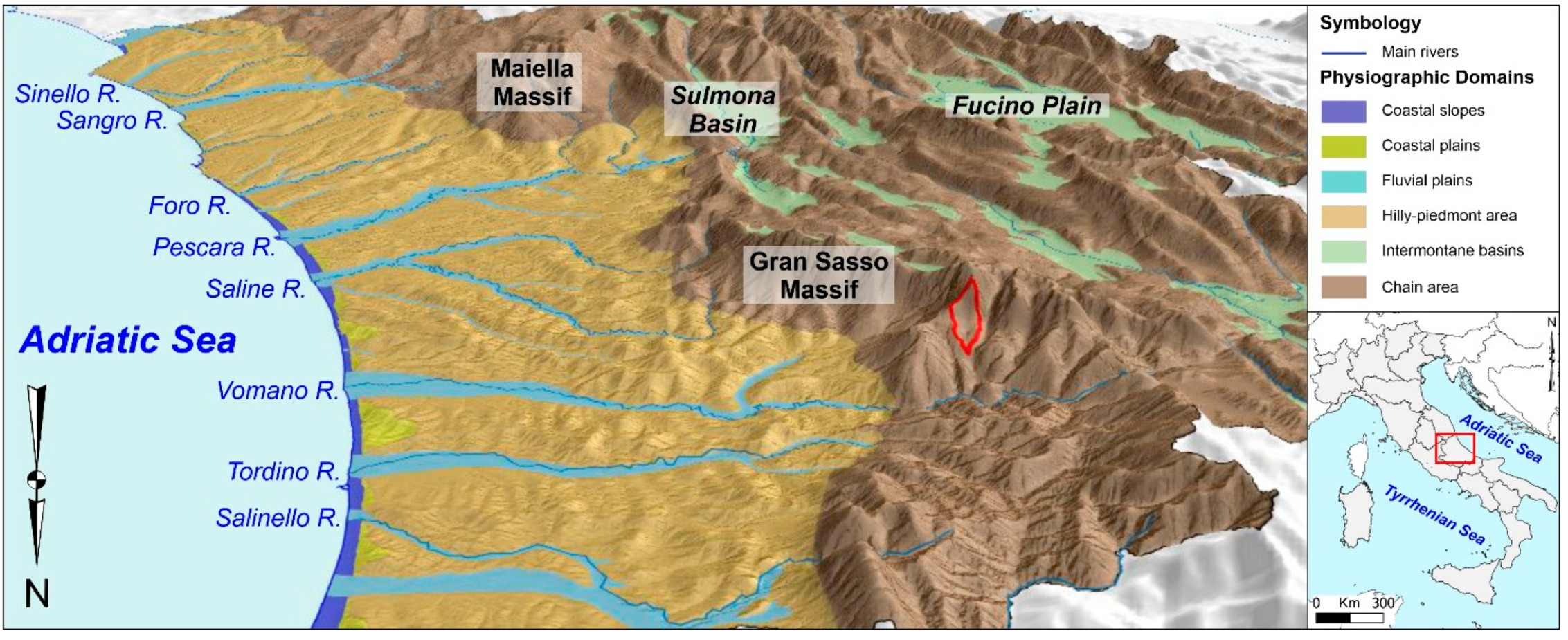
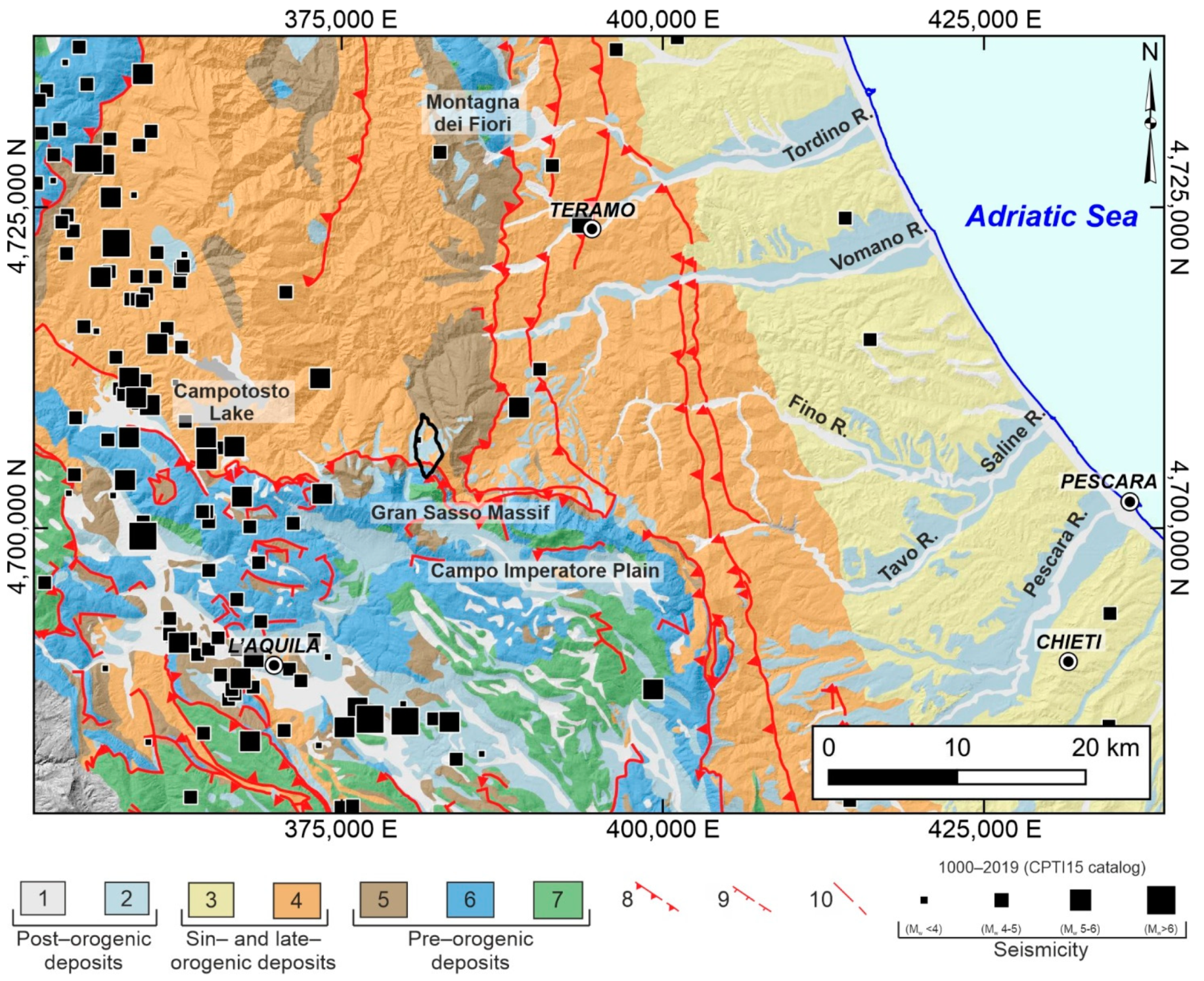

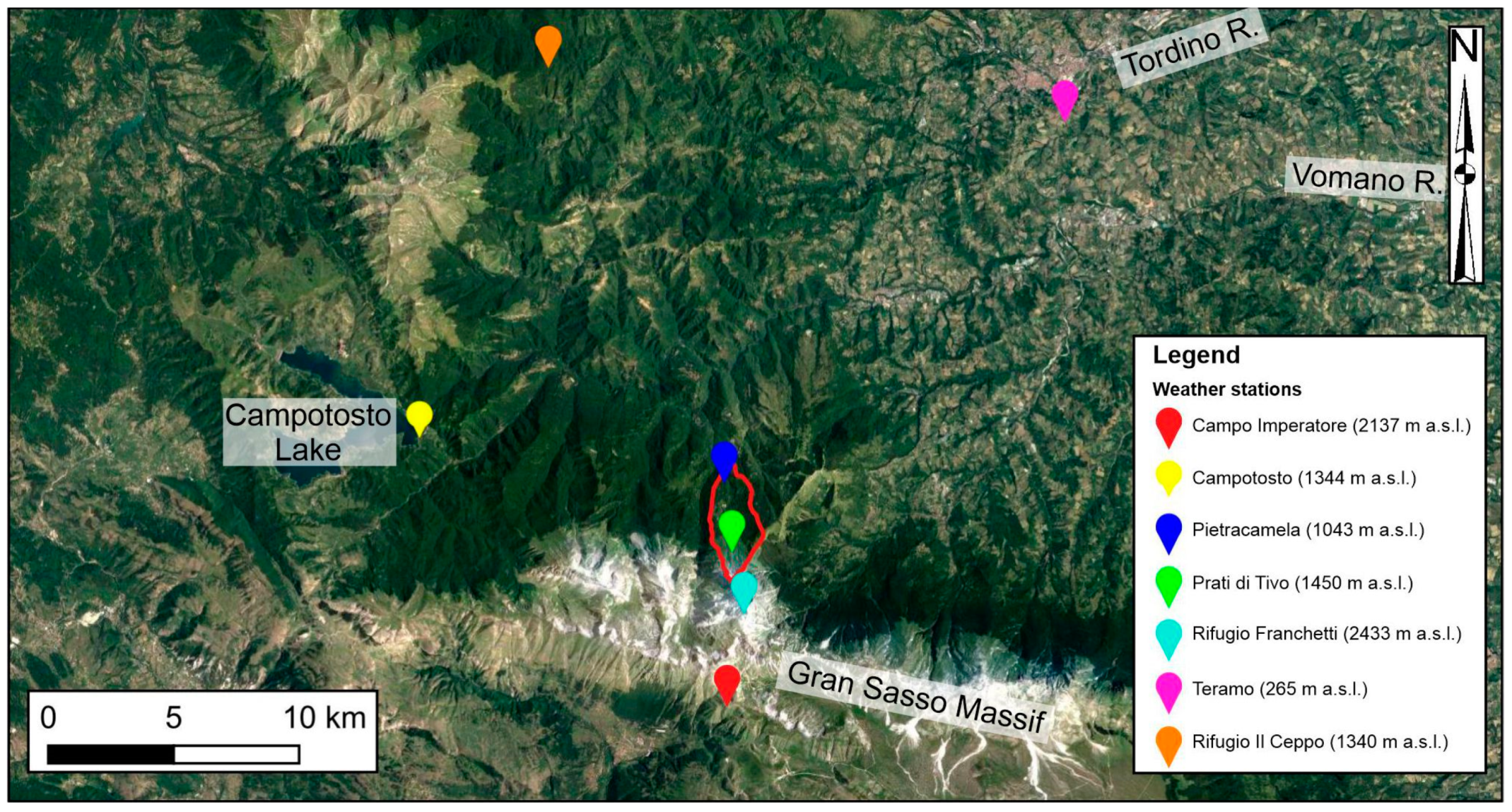
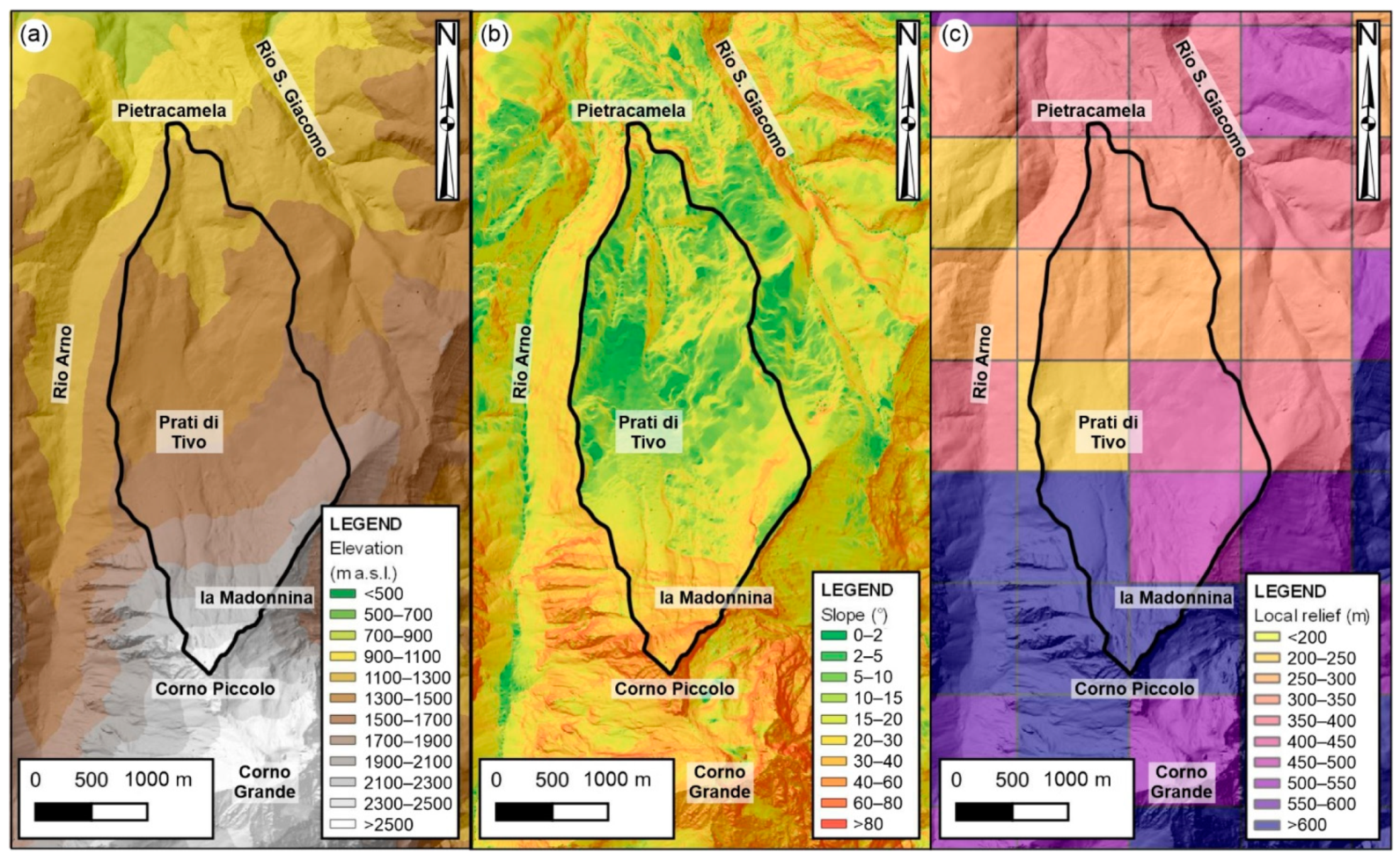
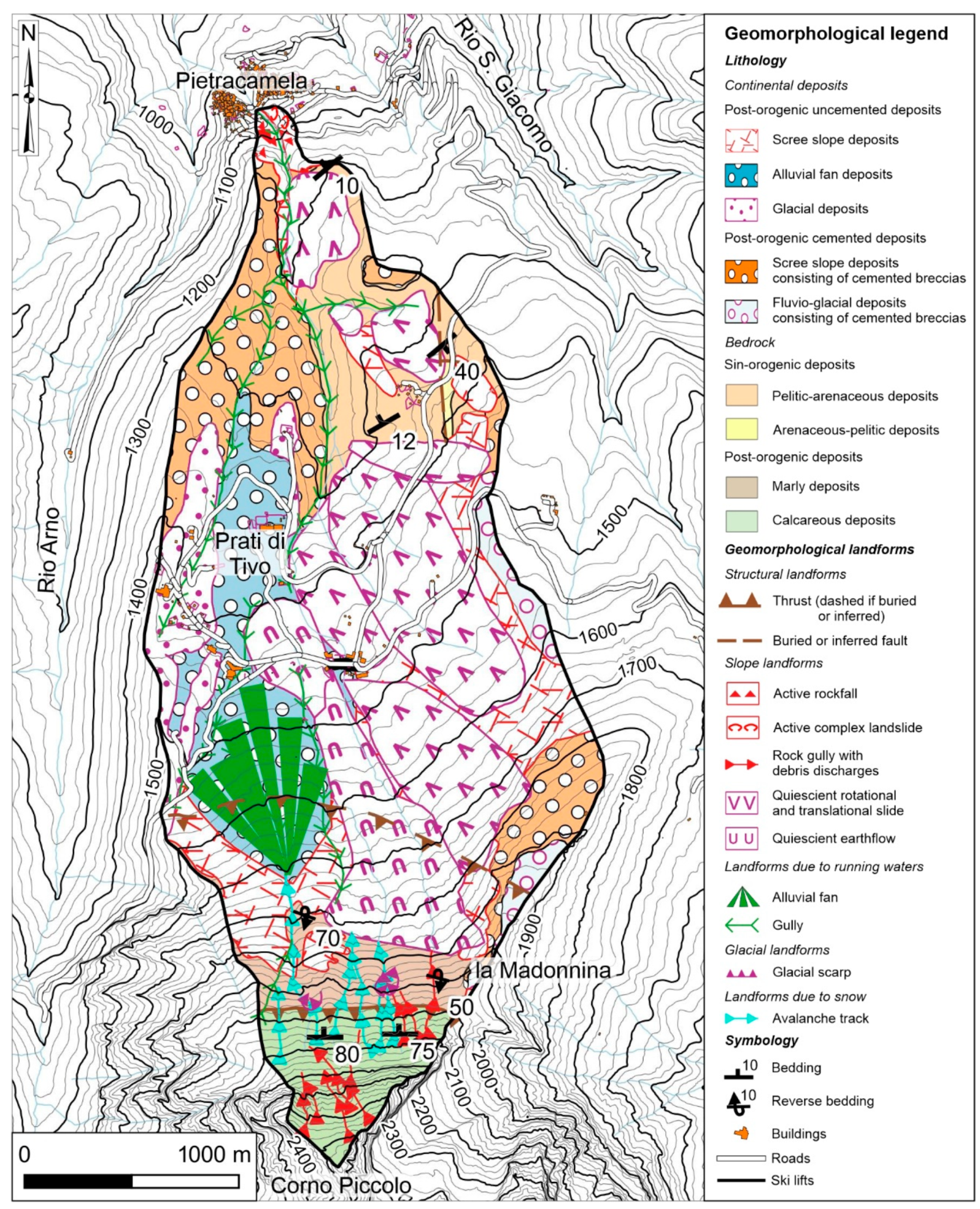
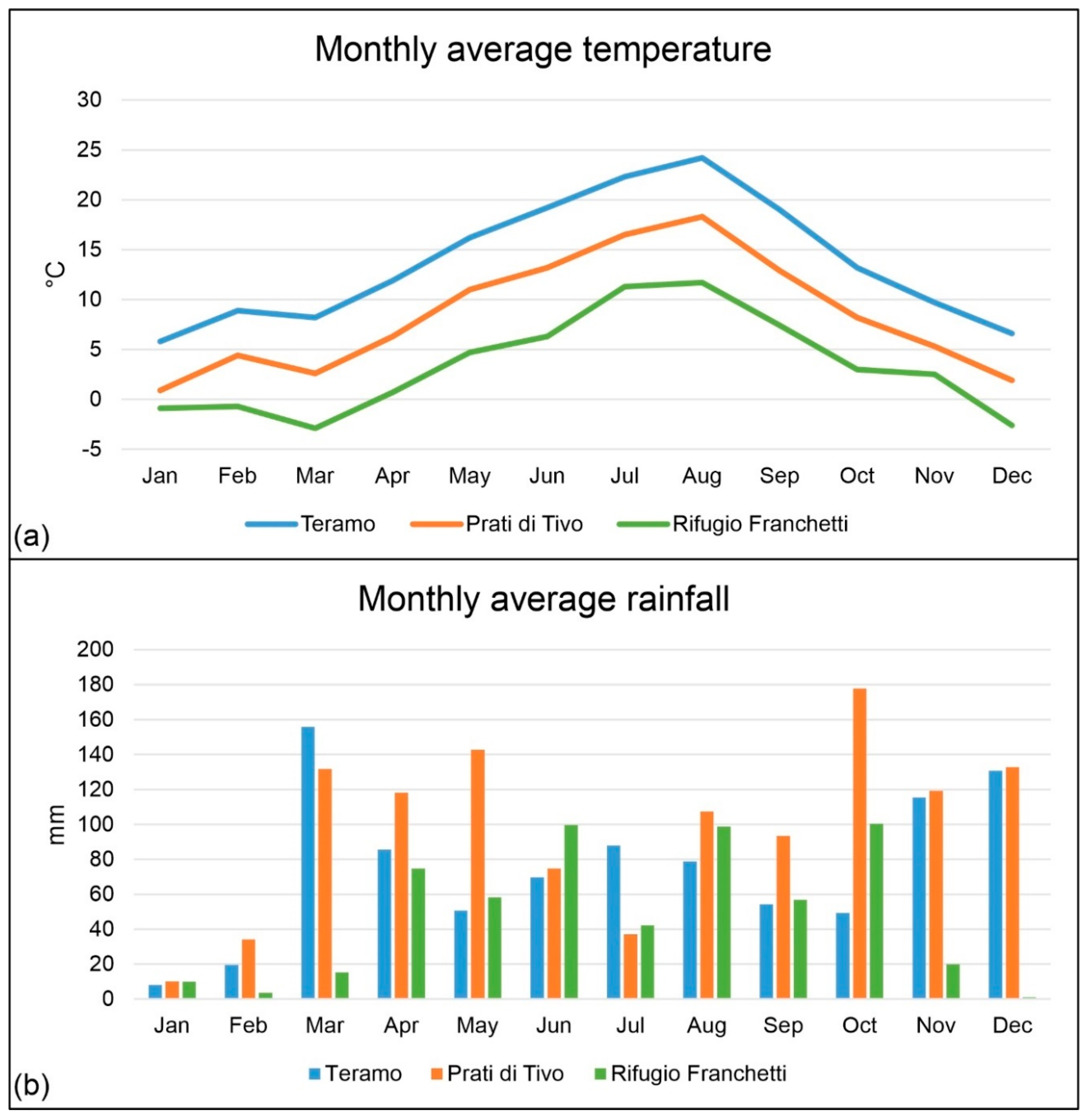
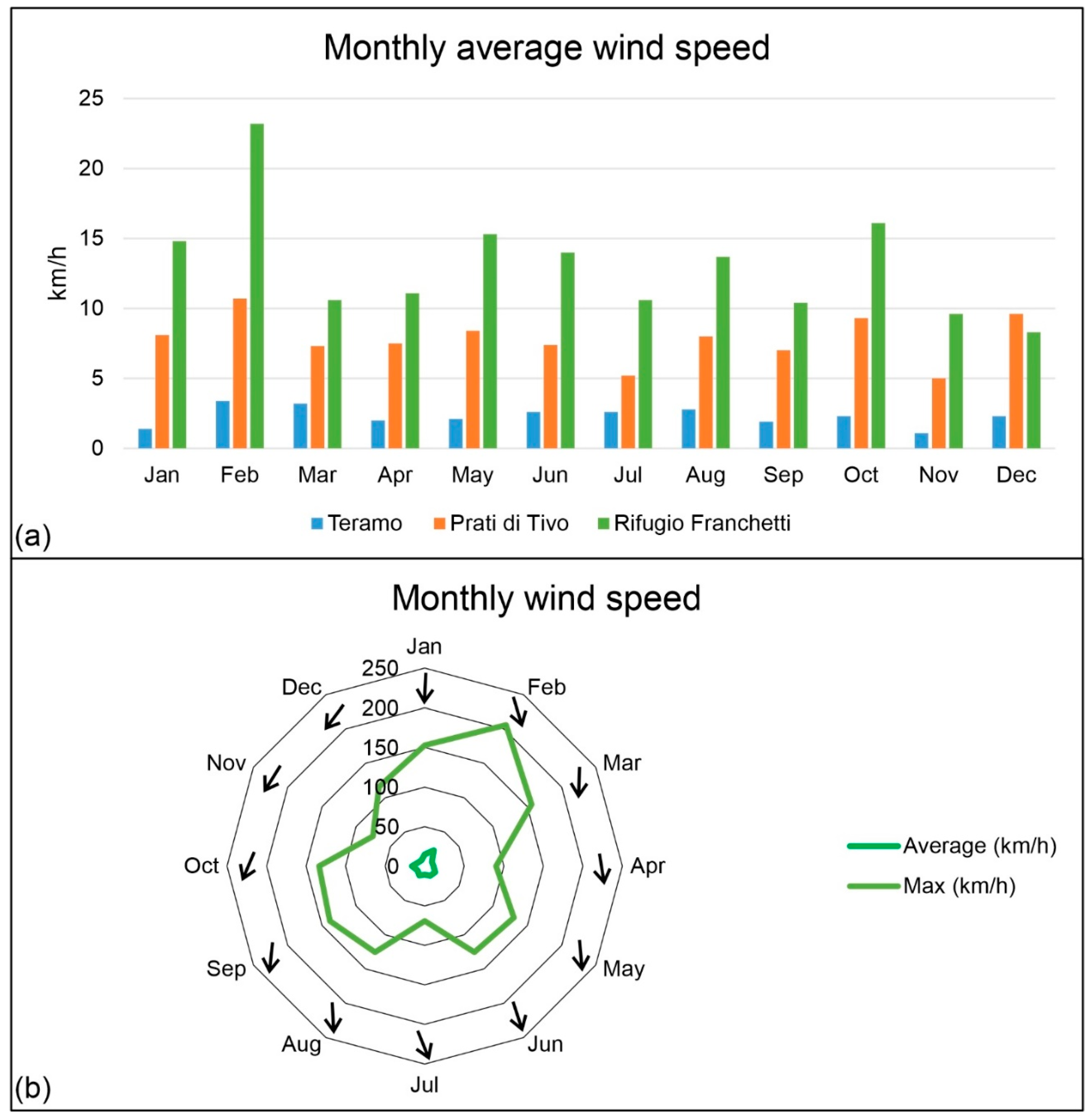
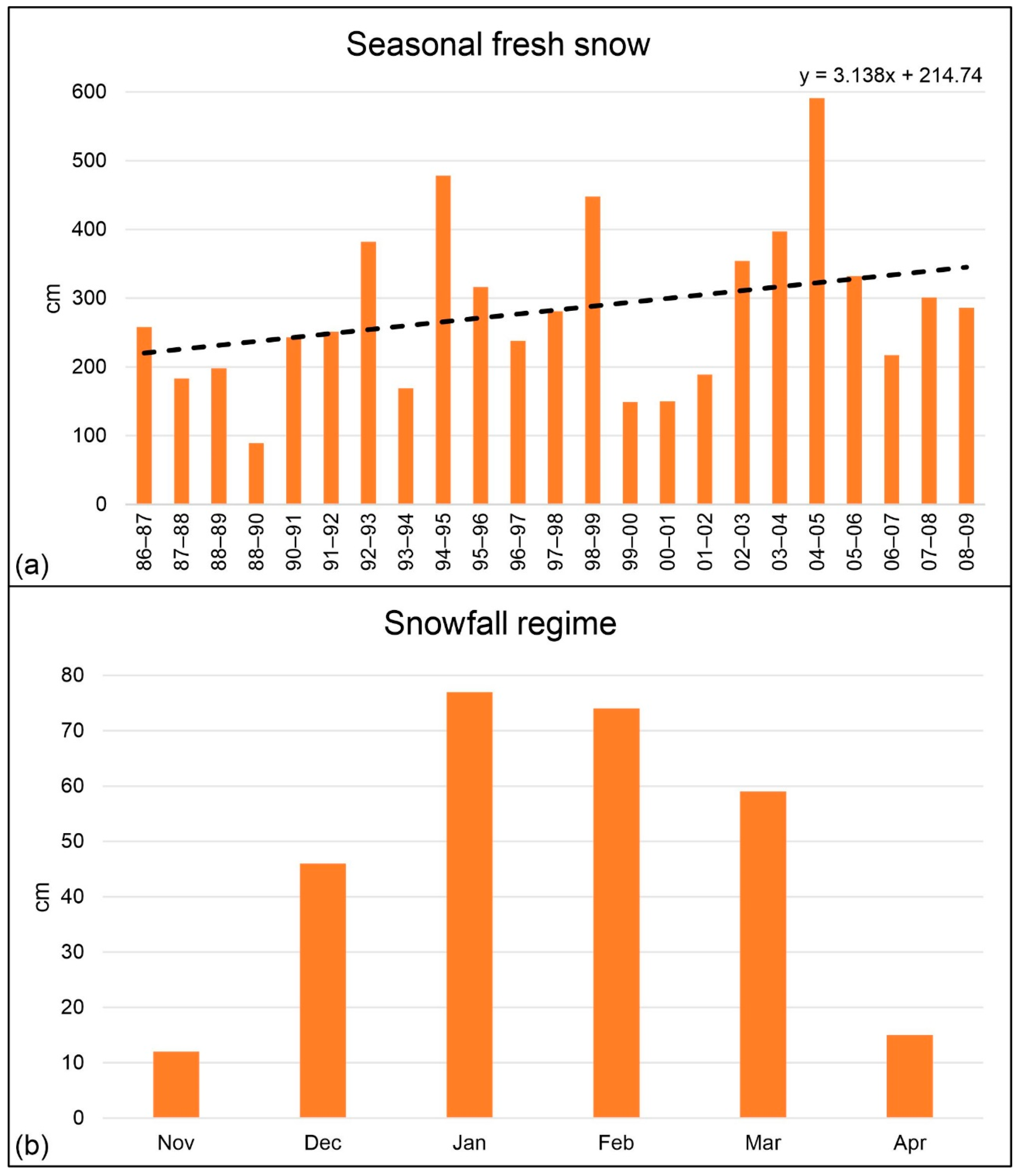

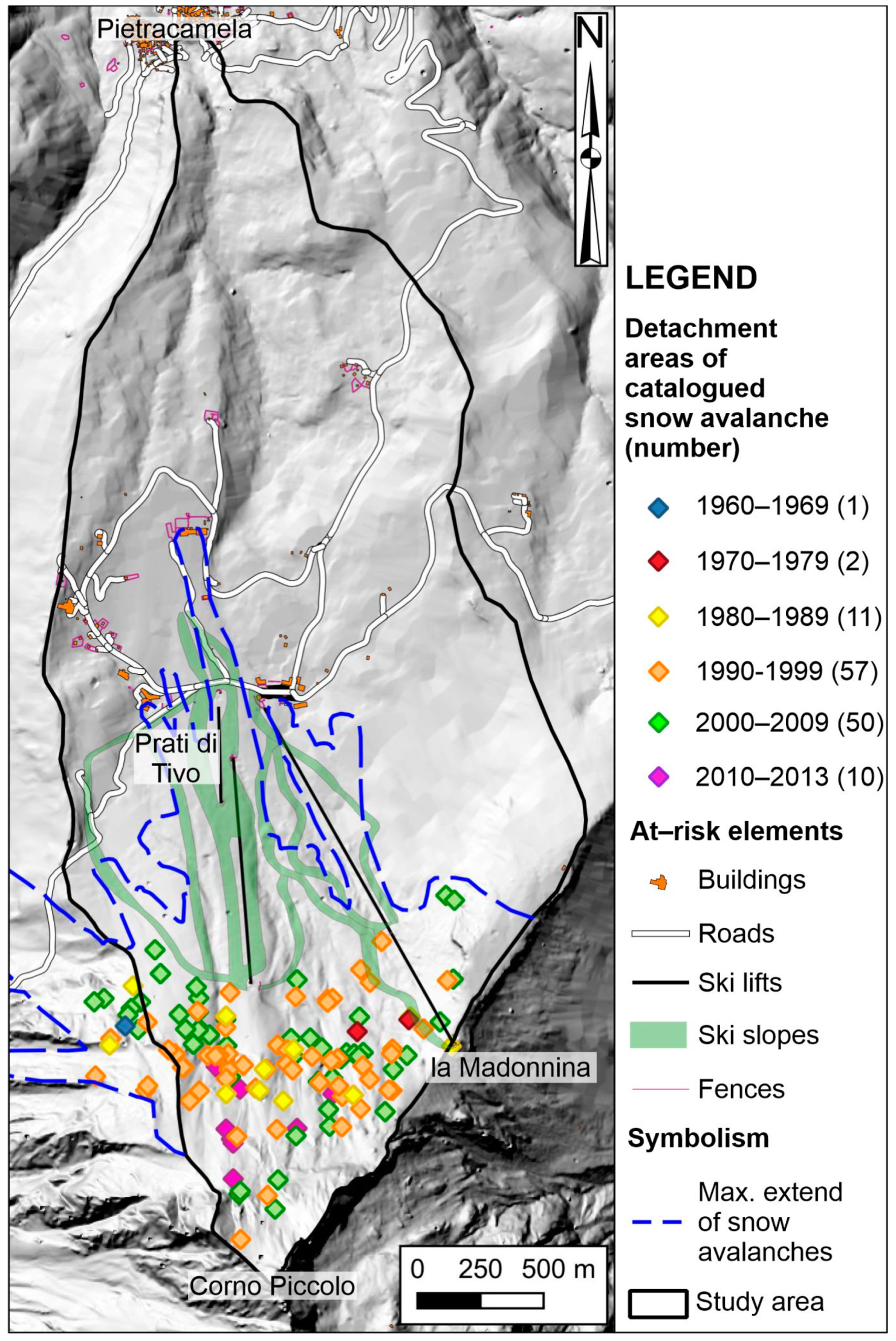
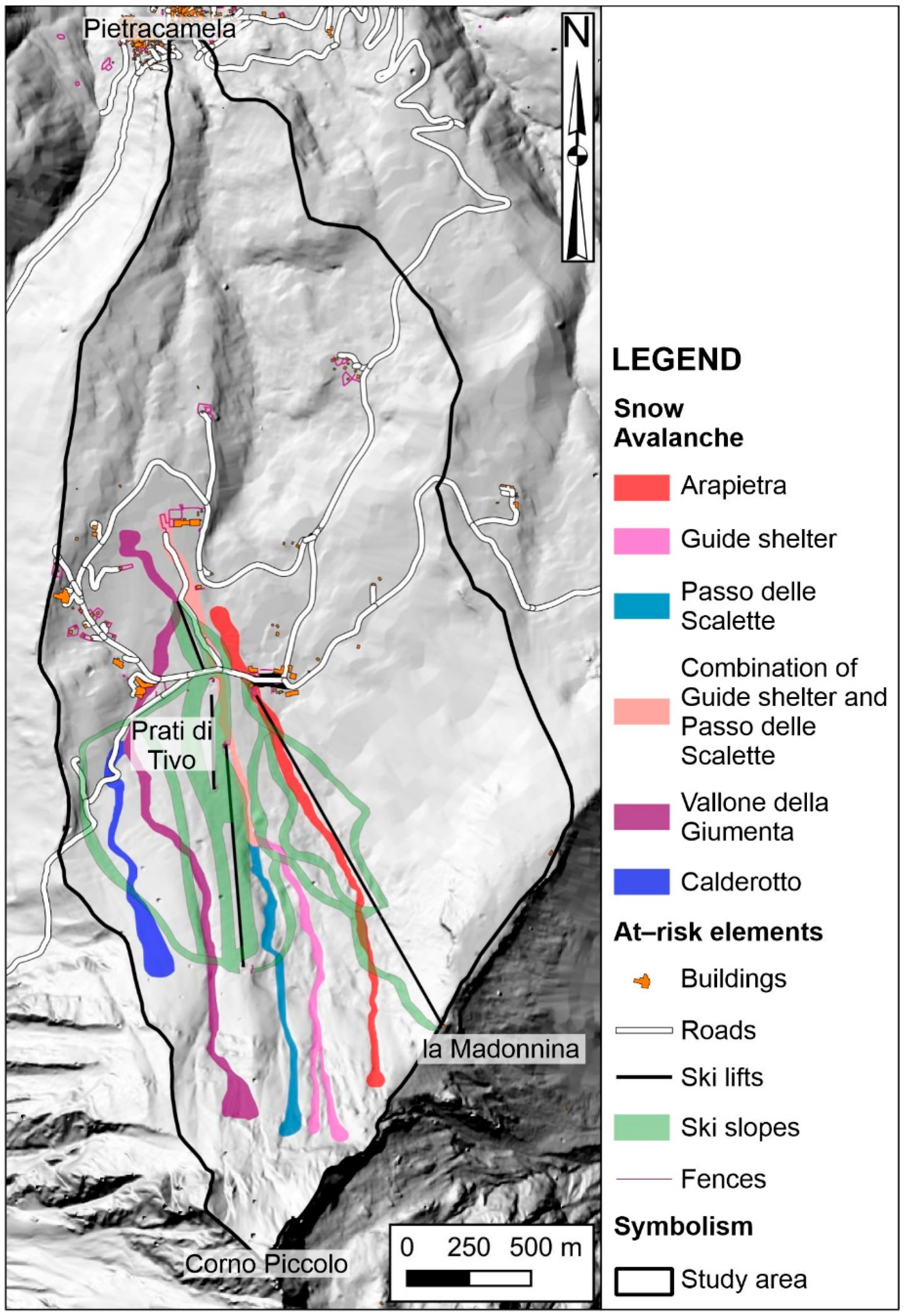
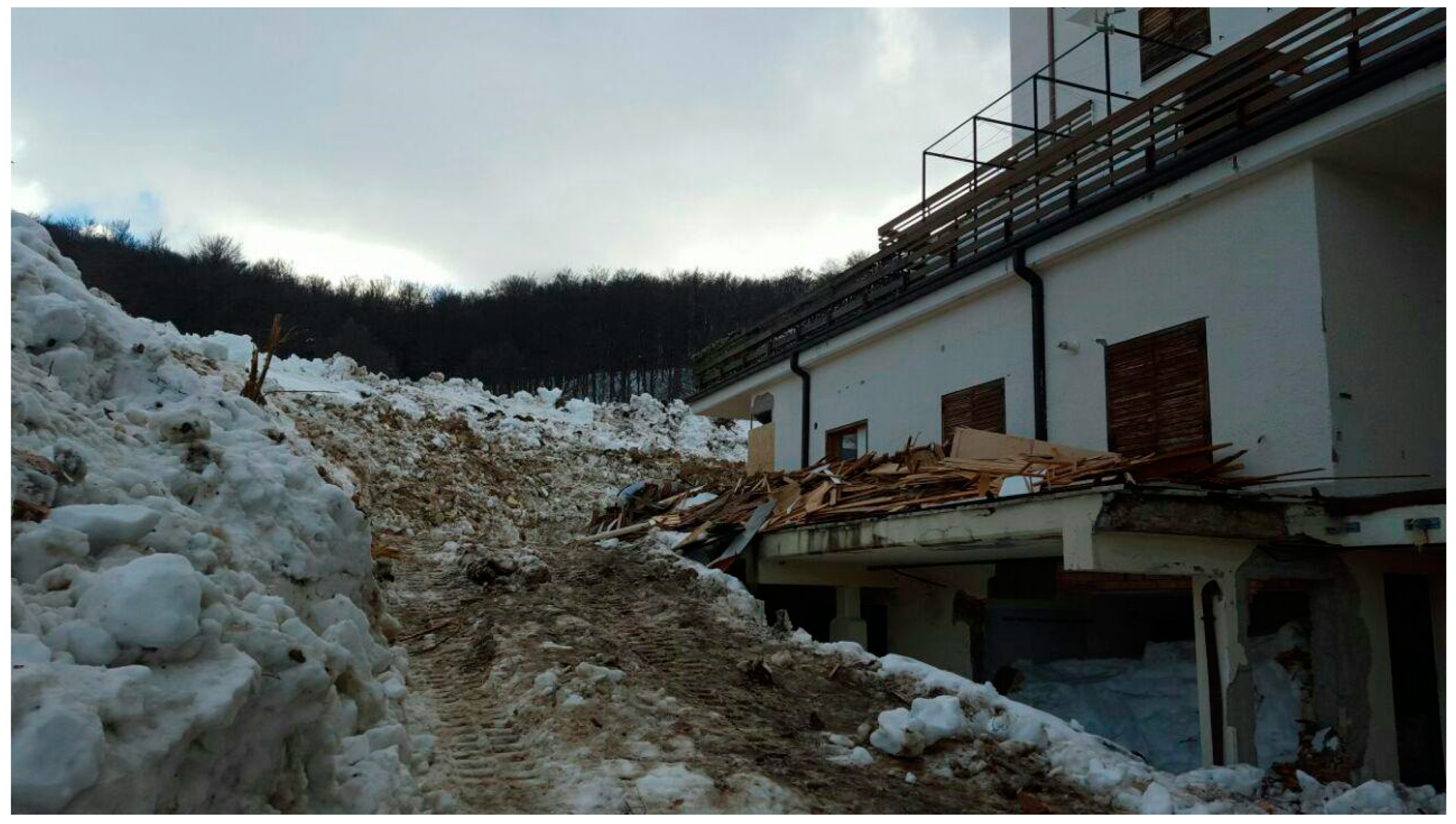
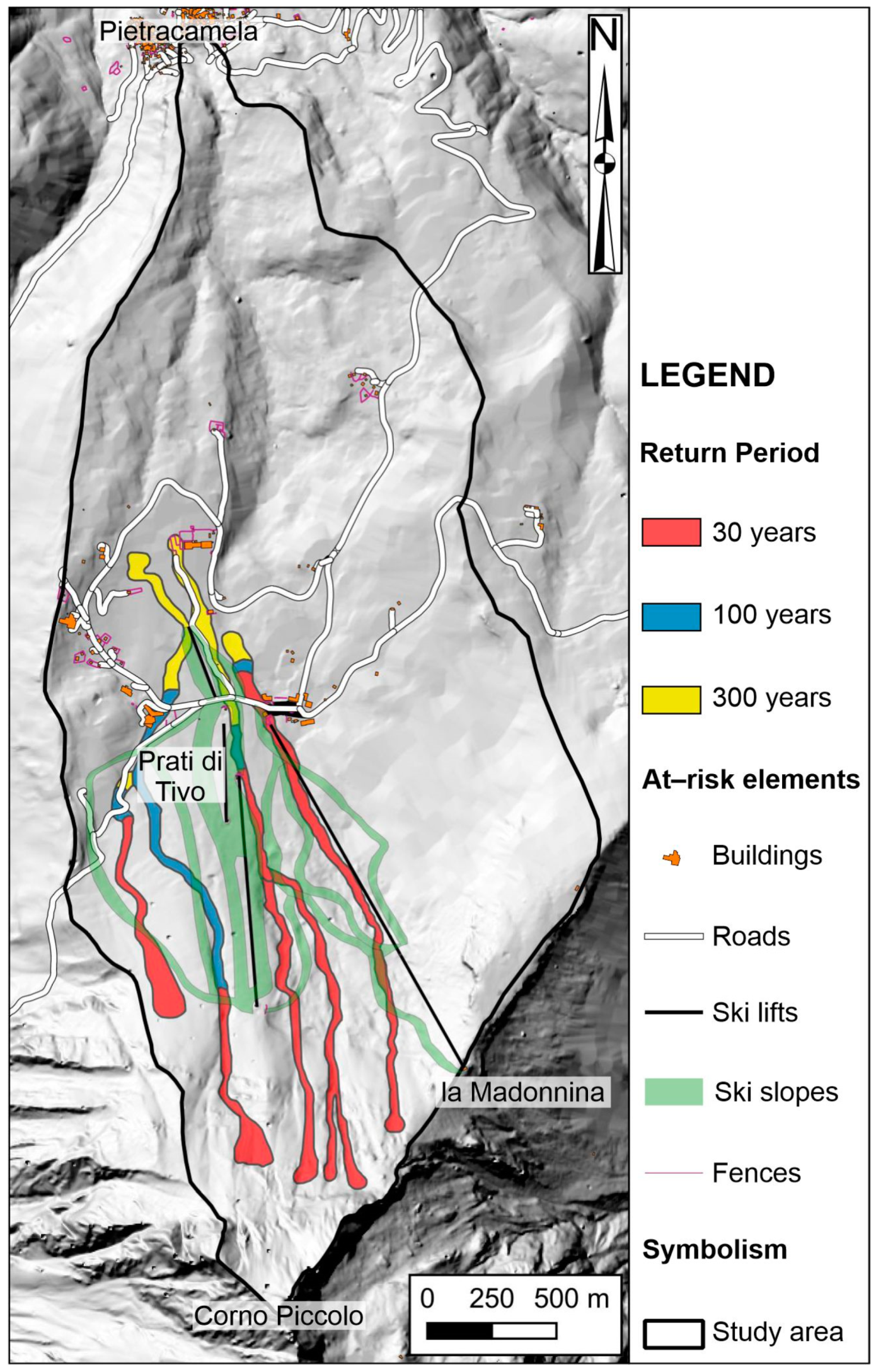
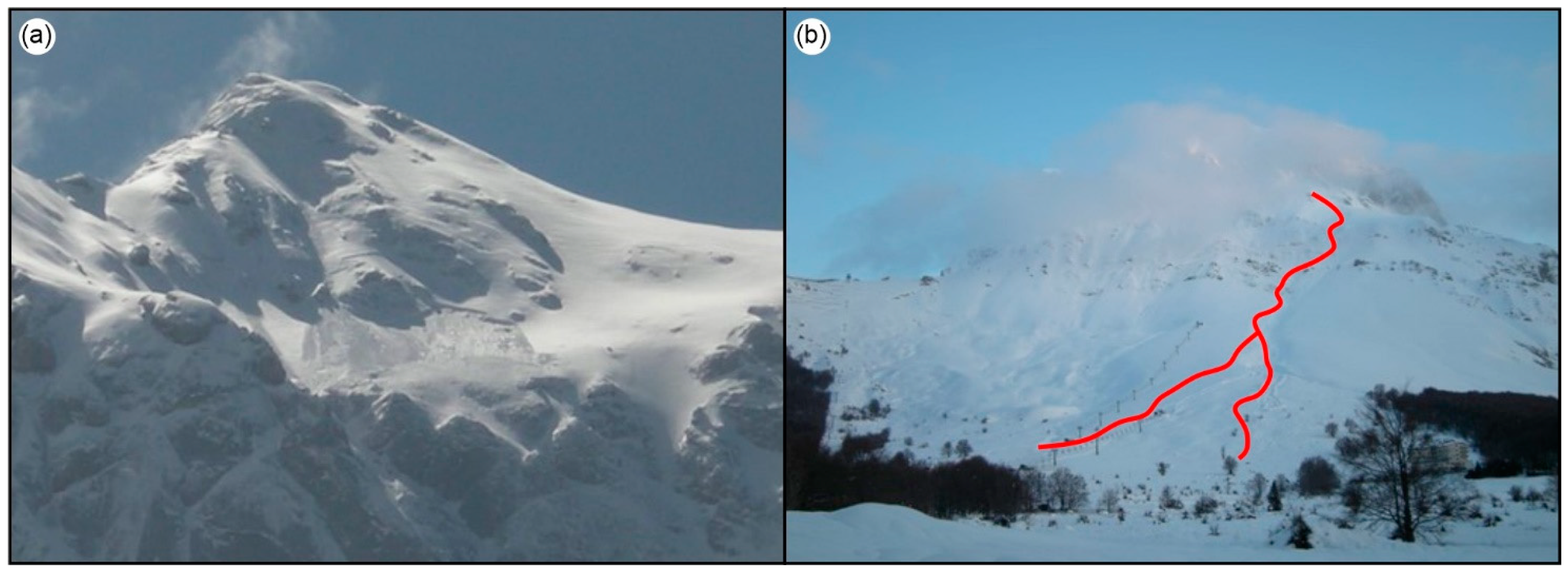
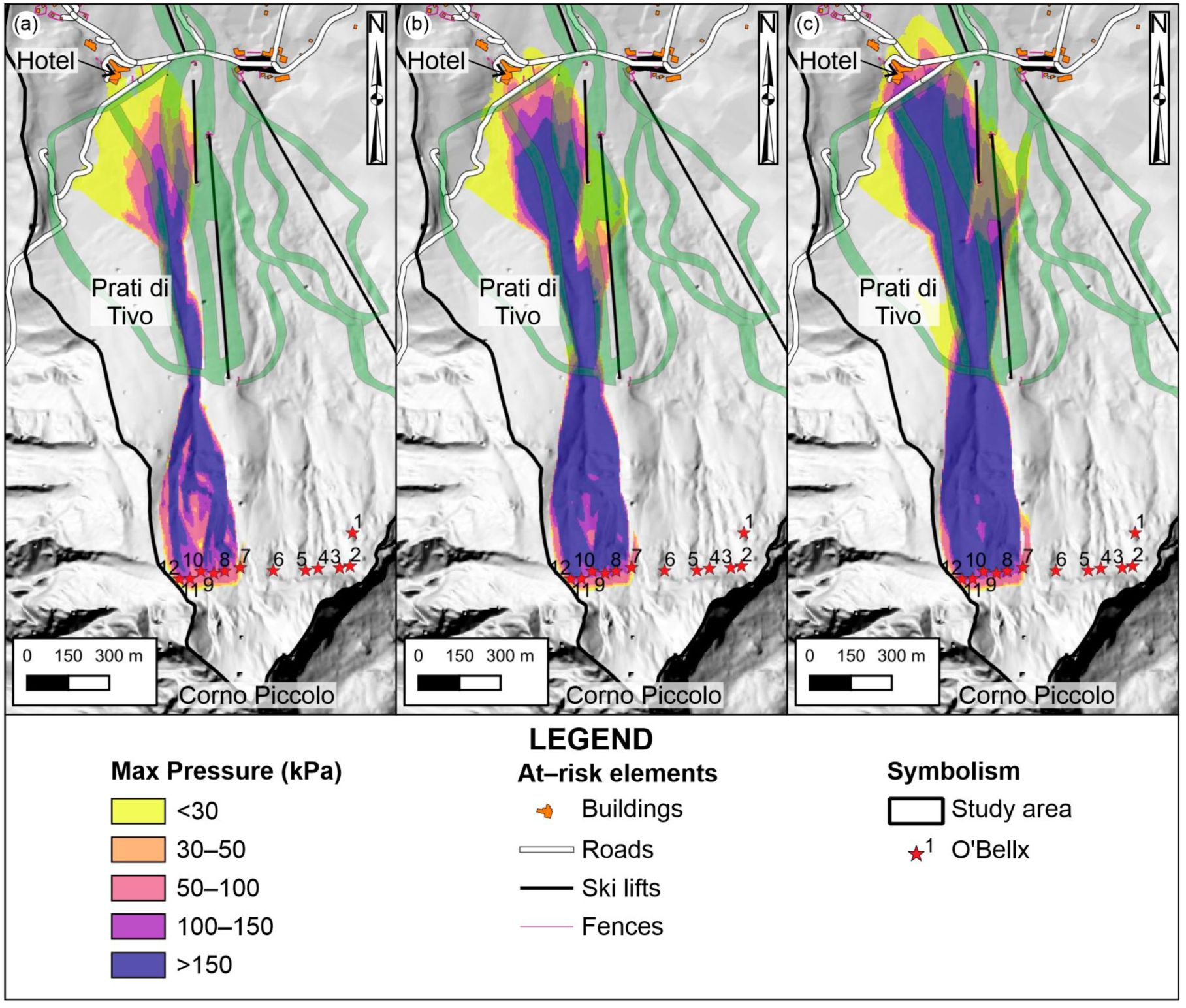

| Zone/Hazard Degree | Definition Land Use Restrictions |
|---|---|
| RED High Hazard | Areas affected either by avalanches with T = 30, even with low destructive power (Pimp ≥ 3), or by highly destructive avalanches (Pimp > 15) with T = 100. New constructions are not allowed. |
| BLUE Moderate Hazard | Areas affected either by avalanches with T = 30 with low destructive power (Pimp < 3) or areas affected by rare events (T = 100) with a moderate destructive power (3 < Pimp < 15). New constructions are allowed but with strong restrictions (low building indexes, reinforced structures, etc.). |
| YELLOW Low Hazard | Areas affected either by events with a low destructive power (Pimp < 3) and T = 100 or by events with 100 < T < 300. New constructions are allowed, with minor restrictions (no public facilities, like schools, hotels, etc.). |
| Yearly Average (1951–2004) | Monthly Average (1951–2004) | |||||||||||||
|---|---|---|---|---|---|---|---|---|---|---|---|---|---|---|
| Temperature (°C) | Temperature (°C) | |||||||||||||
| Jan | Feb | Mar | Apr | May | Jun | Jul | Aug | Sep | Oct | Nov | Dec | |||
| Frost days | 65 | Frost days | 16 | 15 | 12 | 4 | 0 | 0 | 0 | 0 | 0 | 1 | 5 | 12 |
| Absolute maximum | 36.8 | Absolute maximum | 19 | 20.7 | 25 | 24.5 | 31.5 | 35 | 35 | 36.8 | 34 | 27.8 | 25 | 22 |
| Daily average | 10.7 | Daily average | 3 | 3.4 | 5.5 | 8.4 | 12.8 | 16.7 | 19.7 | 19.8 | 16 | 11.3 | 7.2 | 4.2 |
| Mean maximum | 14.6 | Mean maximum | 6.5 | 7.2 | 9.4 | 12.4 | 17 | 21.2 | 24.5 | 24.6 | 20.2 | 14.9 | 10.4 | 7.4 |
| Mean minimum | 6.7 | Mean minimum | −0.4 | −0.5 | 1.5 | 4.4 | 8.7 | 12.3 | 14.9 | 14.9 | 11.8 | 7.7 | 4 | 1.1 |
| Absolute minimum | −14 | Absolute minimum | −14 | −12.8 | −12.1 | −7 | −0.5 | 3 | 4.5 | 4 | −1.3 | −7 | −7 | −13 |
| Rainfall (mm) | ||||||||||||||
| Total rainfall | 1065.3 | |||||||||||||
| Maximum in 1 h | 57.8 | Jan | Feb | Mar | Apr | May | Jun | Jul | Aug | Sep | Oct | Nov | Dec | |
| Maximum in 24 h | 268.6 | Total rainfall | 85.4 | 74.8 | 95.7 | 110.4 | 82.5 | 68.1 | 44.9 | 51.8 | 78.3 | 117.1 | 136.3 | 120.0 |
| Rainy days | 106 | Rainy days | 8.5 | 9.1 | 9.7 | 10.6 | 10.0 | 8.0 | 6.2 | 5.8 | 7.2 | 9.8 | 10.8 | 10.6 |
| Return Time (Year) | ||||||||||
|---|---|---|---|---|---|---|---|---|---|---|
| Hs (t) cm | 5 | 10 | 15 | 30 | 50 | 100 | 150 | 200 | 300 | 500 |
| 154 | 177 | 191 | 213 | 229 | 251 | 263 | 272 | 285 | 301 | |
| Return Time (Year) | ||||||||||
| DH3gg (t) cm | 5 | 10 | 15 | 30 | 50 | 100 | 150 | 200 | 300 | 500 |
| 64 | 78 | 86 | 99 | 109 | 122 | 130 | 135 | 143 | 153 | |
| Pre-Avalanche Landslide Area (km2) | Snow Avalanche Area (km2) | Post-Avalanche Landslide Area (km2) |
|---|---|---|
| 0.363 | 0.645 | 0.769 |
Publisher’s Note: MDPI stays neutral with regard to jurisdictional claims in published maps and institutional affiliations. |
© 2021 by the authors. Licensee MDPI, Basel, Switzerland. This article is an open access article distributed under the terms and conditions of the Creative Commons Attribution (CC BY) license (https://creativecommons.org/licenses/by/4.0/).
Share and Cite
Fazzini, M.; Cordeschi, M.; Carabella, C.; Paglia, G.; Esposito, G.; Miccadei, E. Snow Avalanche Assessment in Mass Movement-Prone Areas: Results from Climate Extremization in Relationship with Environmental Risk Reduction in the Prati di Tivo Area (Gran Sasso Massif, Central Italy). Land 2021, 10, 1176. https://doi.org/10.3390/land10111176
Fazzini M, Cordeschi M, Carabella C, Paglia G, Esposito G, Miccadei E. Snow Avalanche Assessment in Mass Movement-Prone Areas: Results from Climate Extremization in Relationship with Environmental Risk Reduction in the Prati di Tivo Area (Gran Sasso Massif, Central Italy). Land. 2021; 10(11):1176. https://doi.org/10.3390/land10111176
Chicago/Turabian StyleFazzini, Massimiliano, Marco Cordeschi, Cristiano Carabella, Giorgio Paglia, Gianluca Esposito, and Enrico Miccadei. 2021. "Snow Avalanche Assessment in Mass Movement-Prone Areas: Results from Climate Extremization in Relationship with Environmental Risk Reduction in the Prati di Tivo Area (Gran Sasso Massif, Central Italy)" Land 10, no. 11: 1176. https://doi.org/10.3390/land10111176
APA StyleFazzini, M., Cordeschi, M., Carabella, C., Paglia, G., Esposito, G., & Miccadei, E. (2021). Snow Avalanche Assessment in Mass Movement-Prone Areas: Results from Climate Extremization in Relationship with Environmental Risk Reduction in the Prati di Tivo Area (Gran Sasso Massif, Central Italy). Land, 10(11), 1176. https://doi.org/10.3390/land10111176









